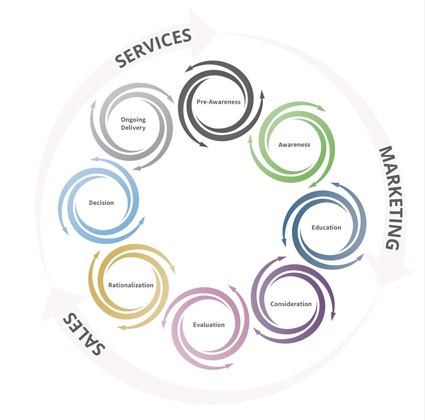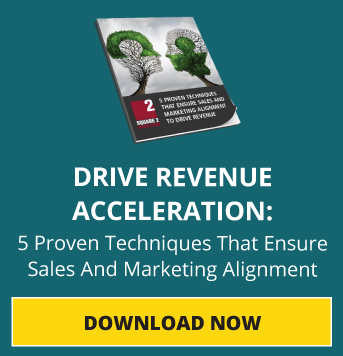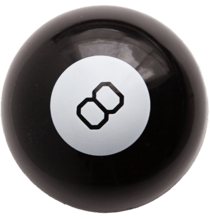
The New Funnel Stages For Digital Marketing And Revenue Generation
The Changes Are More Dramatic Than You First Thought
 I published an article a few days ago titled “What Does Today’s New Revenue Generation Funnel Look Like?” When we reviewed performance for the article (like good metrics-based digital marketing pros do), we saw a 4x improvement in views and a 10x improvement in click-through rates, which in turn generates leads — more leads than most of our blog articles.
I published an article a few days ago titled “What Does Today’s New Revenue Generation Funnel Look Like?” When we reviewed performance for the article (like good metrics-based digital marketing pros do), we saw a 4x improvement in views and a 10x improvement in click-through rates, which in turn generates leads — more leads than most of our blog articles.
What does that mean? It means we need to talk about this topic more frequently. It means we need to go into more detail on what changes are happening to the revenue funnel and provide our readers with more actionable insights they can use to drive leads, sales opportunities and more new customers for their businesses by using some of the data and insights we’ve uncovered.
Here we go!
The New Funnel Stages
Most marketers are familiar with the awareness, consideration and decision-making funnel. It’s large at the top and narrow at the bottom. People or prospects come into the top and they work down and out the bottom as new customers.
I wanted to find out when and where that original funnel concept came from, and without much work, I discovered it’s over 100 years old. According to Wikipedia, “The purchase funnel, or purchasing funnel, is a consumer-focused marketing model which illustrates the theoretical customer journey towards the purchase of a product or service.
“In 1898, E. St. Elmo Lewis developed a model which mapped a theoretical customer journey from the moment a brand or product attracted consumer attention to the point of action or purchase. St. Elmo Lewis’ idea is often referred to as the AIDA-model, an acronym which stands for awareness, interest, desire and action.”
Sound familiar? I think it’s safe to say that the world has changed a little bit since 1898.
In the article I mentioned above, we’ve attempted to redesign the customer journey, removing the funnel metaphor and replacing it with a series of cycles or cyclones. I like cyclones because they illustrate randomness and the external force that comes along with weather. It’s possible that prospects get stuck in a cycle or cyclone and cannot get out for a variety of practical and realistic reasons, which we talked about in that article and will talk about again here.
Let’s look at this illustration of today’s customer journey as it relates to each of the specific stages.

Pre-Awareness
You might find the phrase “pre-awareness” strange, difficult to understand or misplaced, but the fact remains that right now some prospects don’t know you exist. They don’t know you have products or services to help them. They might not even know that these products or services exist. They have the specific pain, issue or challenge that you help with, but for whatever reason, they don’t know or think solutions are available.
You can call this state something other than pre-awareness, but the situation remains. Prospects are unaware that you have the solution to their pain. Since they’re not aware, we call that pre-awareness.
However, since we already established that they have the pain, a pain trigger can move them from pre-awareness to awareness. That pain can be internal or external. If it’s internal, we (the marketers) rarely know about it, but that internal pain trigger often pushes the prospect out of pre-awareness and kicks off their buyer journey.
The pain trigger can also be external. This is where marketing comes in. By providing a disruptive, emotional and compelling message to a prospect in pre-awareness, you can wake them up, get them scared or move them to act because of the emotion your message stirs up.
It’s critical to recognize this stage and make sure you have tactics that include the external pain-triggering messaging required to move your prospects to act and engage with your company.
Awareness
 Everyone is usually clear on the awareness stage. It’s when people start looking around for solutions. They might not be sure or know exactly what they’re looking for, but they’re looking. It’s the first proactive step they’re taking in their buyer journey.
Everyone is usually clear on the awareness stage. It’s when people start looking around for solutions. They might not be sure or know exactly what they’re looking for, but they’re looking. It’s the first proactive step they’re taking in their buyer journey.
If you think about your own behavior, typically this starts with asking friends, family, colleagues, peers or associates if they know anything about the area you’re looking into. This might be quickly followed by (or done in conjunction with) a search on the search engines. Sometimes this searching and asking happens on social media. For example, you might ask if anyone knows of a good plumber in the area. That should sound familiar, too.
This stage is important to marketers, because quite often, the first to be found or referred has the best chance to land the customer. This is especially relevant as we start to talk about tactics. Do people refer you? Do people have amazing experiences that they can’t wait to share? Can people find you on the search engines? Can they find you for the right keywords? Can they find you on social? Are people talking positively about you on social? What about reviews? Are they positive? Do you have them?
Another aspect worth talking about during the awareness stage deals with people’s patience and attention span today. Everyone wants immediate results. Marketers don’t want to wait until their prospects start looking for them. This is why outbound marketing tactics and outbound sales tactics continue to be relevant.
We’re not waiting for our prospects to look for us; we’re going to call them. We’re not waiting for our prospects to find us; we’re emailing them. We’re not waiting for our prospects to know they need us; we’re going to get them at this trade show. Account-based marketing (ABM) is one example of a proactive outbound tactic that can be highly effective. As long as you recognize the risks and the rewards with this approach, it can be an appropriate set of tactics.
Education
 The next phase, as we see it, is education or research around the interest in doing something (or buying something different) than what they’ve been doing (or buying).
The next phase, as we see it, is education or research around the interest in doing something (or buying something different) than what they’ve been doing (or buying).
Generally, the idea is that people are actively educating themselves on the options bundled in the awareness and consideration stages, but we think this is actually a separate stage.
Once you’re aware a solution exists or aware you have a situation that needs your attention, then you go about getting educated on your options. This is a separate stage today because the content available for educating prospects is massive.
It’s the perfect reason we picked the cyclone to illustrate each stage. The sheer amount of material available to prospects is enough to keep them occupied or spinning indefinitely. And in fact, it often does keep them in this stage much longer than ever before and much longer than necessary.
The more you search, the more you find. The more you read, the more you realize there’s more to learn. The more you learn, the more you start to realize different opinions, different approaches and different methods all report to deliver the same value. The internet has made small companies look big, novices look like experts, established companies look inexperienced and experts look invisible.
The result is often an educational effort that produces more questions than answers, further contributing to the cyclone’s continued spin and the prospect’s inability to move from one cycle to the next. Eventually, they find a trustworthy resource (regardless of actual expertise) that is able to make an emotional connection through content. Typically, that resource settles in as the guide that is able to move them from one cycle to the next.
Decision To Buy
What moves a prospect from one cycle to the next is a decision. When you’re unaware and moved to act because of information or action, you decide to start looking around and ask questions. When you’re now aware and want to learn about your options, you decide to start getting educated in order to make a safe and smart purchase decision. When you feel like you have enough education, you decide to start talking to a handful of solution providers — the consideration stage.
At each stage, a decision is made that moves you from one cycle or cyclone to the other. It’s important to know that and recognize that marketing and sales need to be good at getting prospects to make those decisions as fast as possible. That’s how you improve conversion rates and shorten sales cycles.
Consideration
 Now that you’ve identified all of the options available, eventually prospects have to start to narrow those down.
Now that you’ve identified all of the options available, eventually prospects have to start to narrow those down.
They start to know what they like and what they don’t like. They start to know what they need and what they don’t need.
They start to recognize what they see that they like and what they hear that they don’t like. It’s allowing them to go from many options to just a few. When they narrow down the potential solutions to just a few, now they enter into the consideration stage, where they start to look more closely at their selected handful of options.
This is where guidance becomes critical. Remember, it’s not a funnel anymore, it’s a series of crazy informational cyclones. This one is no different. If you want to help your prospect navigate through the storms, you have to be able to show them clearly what makes your option different, better, faster, cheaper, more strategic and more valuable than the other handful of options.
You need to do it in a way that is aligned with their buyer journey. You can’t sell them or control them, you have to guide them. Typically, around this time in their journey, the sales team is getting introduced. There’s a handoff. The guided approach has to continue from marketing and into sales. The sales guide needs to become the trusted advisor, continuing to help them navigate the upcoming cyclones, because a couple more are coming.
Decision To Buy From Three
In the consideration stage, they’re narrowing down the huge collection of options to a manageable number. For the sake of argument here, let’s say they’re considering three companies. It’s usually the companies that have done the best job in the sales process or the best job leveraging their marketing to help the prospect know, like and trust them.
Again, marketing and sales that matches the buyer journey is so critical to even getting to this point. It’s a tumultuous process and a bumpy experience for the prospect and the providers. Next, the process of evaluating the finalists begins, and the buyer journey enters the next stage — the evaluation stage.
Evaluation
 Now that they’re serious, the hard work usually starts for prospects. One or two people may have done the research and background work. But now that they’re looking at pricing, presentations, capabilities, team members, features and benefits, the power people are involved.
Now that they’re serious, the hard work usually starts for prospects. One or two people may have done the research and background work. But now that they’re looking at pricing, presentations, capabilities, team members, features and benefits, the power people are involved.
In some cases, procurement is involved. In other cases, formal RFP processes are executed, and presentations are scheduled. Some companies will go so far as to create a scoring matrix.
Your job? Stand out. Make sure that when their process is over, no choice needs to be made. You stand out as the only company, product or service for them. Your company has provided the information to make them 100% certain you’re the only company that can deliver.
This is a marketing and a sales executable — the story, the details in the deck and the answers to the questions in the RFP. The content needs to be crafted in a way that tells a story, highlights the prospect’s decision-maker as the hero of the story and provides any necessary supporting details to make that story emotional and compelling. Do that and you’ll be moving on. Fail and you’ll be one of two companies not moving on.
Rationalization
You’re trying your hardest to work through this incredibly challenging set of cycles, and you’re almost to the end, except the team selecting the final winner is asking a lot of hard questions. That’s because you’re out of the emotional stage of decision-making. You’ve entered into the rationalization stage of decision-making. Check out this article on the differences.
This stage is where you get to answer the tough questions. When do you expect me to see positive ROI on the investment? What are your payment terms and are they flexible? Who will we be working with specifically on this project? What guarantees do you offer? Can you include this extra set of features for no additional cost? When do you expect delivery to be completed?
They’ve already emotionally decided they want to work with you. You’ve won the business emotionally, but getting over these questions is usually a lot harder. The point of separating out these two decision-making vectors is to have marketing and sales prepared to deal with both emotional and rational decision-making stages in the new buyer journey.
Sorry, but it gets worse. Harvard Business Review reports that the number of people involved in B2B solution purchases has climbed from an average of 5.4 people two years ago to 6.8 people today, and these stakeholders come from a lengthening roster of roles, functions and geographies. The resulting divergence in personal and organizational priorities makes it difficult for buying groups to agree to anything more than “move cautiously,” “avoid risk” and “save money.”
Wow, that is depressing. All the more reason for having your sales process buttoned up, remarkable and designed specifically to deal with the environmental factors described above.
Decision To Buy From One
But wait, you got the deal. They picked you. You should be thinking, “Great, they picked us; we win!” But that’s not the case in reality. It’s just one step in bringing the prospect journey to an end. In most cases, you still have to talk about contract details, agreement terms and other “legal” aspects of your new working relationship. You can celebrate, but the paperwork isn’t signed yet, and in my opinion, this buyer journey still can come to a crashing end.
Decision-Making
 It’s not a done deal until that paperwork gets signed. Nothing fancy here. We’ve all been through it. Some companies want their procurement team to deal with it, while others rely on their legal team. Some businesspeople buckle down and prove value by beating you up over terms that seem basic, fair and standard to you. Another series of cycles is required to get through this final stage.
It’s not a done deal until that paperwork gets signed. Nothing fancy here. We’ve all been through it. Some companies want their procurement team to deal with it, while others rely on their legal team. Some businesspeople buckle down and prove value by beating you up over terms that seem basic, fair and standard to you. Another series of cycles is required to get through this final stage.
To try and keep these cycles as limited as possible, you can go back to what makes your company special. The more unique you are, the more leverage you have to say “no.” The more generic your offering, the more likely you’re going to run into issues here.
Consider the procurement piece. If they can’t get what you offer from anyone else, how aggressive are they going to be in working your price down? But if all three of your competitors offer the same (or similar) products or services, it’s going to be ugly. You don’t want to lose the deal after all that work, time and energy.
You Won!
Yes, the paperwork is signed, and you have a new customer. Rejoicing and celebrations ensue. Gongs are rung, emails are sent and champagne is shared. It’s a party — especially when the deals are big, because long, complex sales almost always end in big-dollar deals.
But this is the first step, not the last. The end game is not getting a new customer but rather getting a new customer to realize the benefits they signed up for when they met you. The end game is making this customer so happy that they tell everyone about you. The end game is getting this customer to buy more from you, to continue working with you into year two and to be an active advocate for your company.
As the new graphic shows you, that final decision cycles you into a series of additional cycles as your new customer considers more services, increasing their spend with you and becoming a vocal advocate for your company. It’s a never-ending cycle, or at least that’s how your revenue team (sales and marketing) should be looking at it in 2018 and beyond.
Square 2 Marketing – Revenue Is Earned With Expertise, Methodology And Insights!

CEO and Chief Revenue Scientist
Mike Lieberman, CEO and Chief Revenue Scientist
Eliminate Hit-or-Miss Marketing Moves
Get advice, tips, tools and guidance to generate more leads for your company in this weekly email newsletter.



Eliminate Hit-or-Miss Marketing Moves
Get advice, tips, tools and guidance to generate more leads for your company in this weekly email newsletter.













